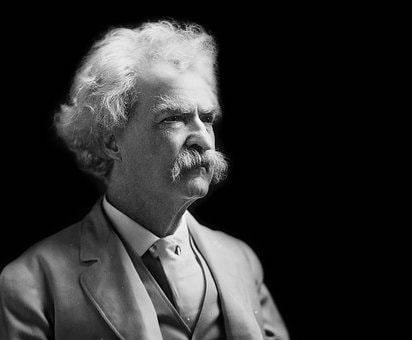Archived Blogs
|
Have you heard about the Green New Deal? I wanted to review the “old” New Deal before I started on the new version. You can read that in my blog here. I ended my blog by saying that with the previous New Deal, the government accepted responsibility for our welfare, not just our protection. Here’s a definition for you. Welfare: social effort designed to promote the basic physical and material well-being of people in need. That's important to know because that's what this proposal is all about. The title “Green” implies that this document is solely about climate change but that’s not correct. It’s much broader than that. The Green New Deal isn’t just about preventing droughts, floods and hurricanes. It’s a vision to address the collapse of the middle class, the escalation of healthcare costs, the stabilization our economy. It proposes to rein in the military, protect our personal liberties and support the local media. Where did the term New Green Deal come from? According to Wikipedia, Thomas Friedman was one of the earlier users of the term. He was a journalist for The New York Times and The New York Times Magazine. In 2007, he wrote, “If you have put a windmill in your yard or some solar panels on your roof, bless your heart.” He went on to explain that it will take more than those minor adaptations and that we needed a New Deal but a green version. Different organizations took up the charge and the concept grew more popular. But, on February 7, 2019, things got really interesting. New York Representative Alexandria Ocasio-Cortez introduced her Green New Deal in the House and Massachusetts Senator Ed Markey introduced the companion resolution in the Senate. What they introduced was a resolution, not a bill. What’s the difference? A resolution is a vision statement... a call to action. A bill can become a law. So what was the big deal? This resolution was the first time this list of goals, modeled after the New Deal, was formally introduced in Congress. And boy, did it get everyone’s attention. The Green New Deal (GND) has several goals.
As expected, everyone has an opinion about the resolution. First, President Trump tweeted: “I think it is very important for the Democrats to press forward with their Green New Deal. It would be great for the so-called “Carbon Footprint” to permanently eliminate all Planes, Cars, Cows, Oil, Gas & the Military- even if no other country would do the same. Brilliant! Nancy Pelosi (Speaker of the House) called it "a green dream". And imagine what those disbelievers in climate change think.... Ocasio-Cortez addressed that issue in a video…“At this point, we don’t even have to prove it. Just walk outside in the winter in a lot of places, and its either way worse than you’re used to or way warmer than you’re used to.”
The New Deal was costly and this Green New Deal sounds even more expensive. Some people have expressed concern that it could bankrupt us. Jeffrey Sachs, in an article on Feb 26, said, “These claims are dead wrong. The Green New Deal agenda is both feasible and affordable. This will become clear as the agenda is turned into specific legislation for energy, health care, higher education, and more.” A lot of articles have been written both in support and opposition. That happened as FDR was unrolling his New Deal too. But this proposal is bigger and more wide-sweeping. The whole plan is wildly audacious, even to those that support some of the principals. And that makes it likely to fail. Bipartisan support for all of those issues? So, was the whole thing a waste of time. ...Maybe not. If the idea was to point attention to the climate, it worked. Prior to now, there hasn't been much discussion and that meant a lot of people didn't take the subject seriously. But, it's a Big Deal. Senator Tom Carper said, "Climate change is real, human activity during the last century is the dominant cause of the climate crisis: and the United States and Congress should take immediate action to address the challenge of climate change." Yes. Diane Feinstein wants to introduce her own alternative proposal and Nancy Pelosi believes that a resolution is not the best way to handle this situation and instead it should be a law. Yes. I'm keeping my eye on this Green New Deal!
0 Comments
Have you heard about the New Green Deal? I confess, I was feeling like I should review the old one before I spent too much time on the new one. It’s pretty interesting stuff and it all started with Mark Twain (The Adventures of Tom Sawyer). Samuel Clemens, also known as Mark Twain, wrote about the river pilots forcing the steamboat owners to meet their wage demands and recognize their union in his memoir Life on the Mississippi. It was a pivotal experience and he wrote about it again, this time in fiction, in his book A Connecticut Yankee in King Arthur’s Court: “…here I was, in a country where a right to say how the country should be governed was restricted to six persons in each thousand of its population…I was to become a stockholder in a corporation where nine hundred and ninety-four of the members furnished all the money and did all the work, and the other six elected themselves as a permanent board of direction and took all the dividends. It seemed to me that what the nine hundred and ninety-four dupes needed was a new deal.” Twain was a supporter of workers and unions. At his regular Monday Evening Club, Twain gave a speech praising the Knights of Labor (KOL). Founded in 1869, the KOL was was the first labor organization in the United States. It originated in secret and was designed to protect its members from retaliation from their employers. From that day on, Labor leaders used Twain’s quote from his Connecticut Yankee book as an inspiration to union members. Did I mention that Connecticut Yankee was one of Franklin D Roosevelt’s favorite books? Let's fast forward to when FDR accepted the Democratic nomination for the President of the US. According to independent producer John McDonough in The Birth of a New Deal, in his final paragraph of his acceptance FDR said: I pledge myself to a new deal for the American people. So, now you know where FDR got his inspiration. But where did the concept for the New Deal come from?
Let me tell you a little about his wife, Eleanor. Elenor was orphaned at a young age, married FDR against the wishes of his mother and then her husband had an affair. Her home life sounded pretty miserable and as Wikipedia says, “she resolved to seek fulfillment in a public life of her own.” She was an outspoken woman who gave speeches and made public appearances. Even worse—sometimes she publicly disagreed with her husband. In short, she was not the typical First Lady. Eleanor was a great supporter of civil rights for African-Americans, Women’s rights…in fact, all Human rights. (She served as the first chair for the United Nations Commission on Human Rights) Eleanor, along with several other women (Nancy Cook, Marion Dickerman and Caroline O’Day), opened up Val-Kill Industries in 1926, a non-profit furniture factory in Hyde Park, New York. The goal of the business was to employ young men and supplement farmer’s incomes by making early American furniture replicas. They created jobs in order to help those in need. Interesting, right? The stock market crashed in 1929, losing 90% of its value. Unemployment was sky-rocketing, the economy was failing and the financial system was in danger of collapse. Franklin Roosevelt had to do something. During his first one hundred days in office, he: Held fireside chats and urged people to put their money back in banks. Stopped Prohibition. (Thank you, sir) Enabled the federal government to build dams to control flooding and provide power to rural areas in Tennessee. (TVA) Gave commodities to farmers to end surpluses and boost prices. The economy increased but it was not enough. The country was still in a depression. So he launched even more programs: The Workers Progress Administration (WPA) created jobs building bridges, schools and highways. (Thank you, Eleanor) Social Security was created to provide pensions to workers and federal government support to dependents and the disabled. Loans were made to farmers. Public housing was created and the US minimal wage was increased. Did it work to pull us out of the Great Depression? Historians still debate this. Those that supported it (Liberals) felt that it did while those against (Conservatives) disagreed. It’s hard to say because in 1941, Pearl Harbor was bombed, and our country was thrown into a war. And war means lots of jobs and lots of money spent on industries supporting the war—so our country recovered. What is the legacy of the New Deal? Many may argue about how effective the New Deal was in restoring our country but most historians agree that the New Deal instituted the following changes: -The New Deal dramatically increased the power of the federal government and the President. -It made a commitment to the people to attend to their welfare, not just their safety. What is welfare anyway? Definition: statutory procedure or social effort designed to promote the basic physical and material well-being of people in need. I bet that last part’s important when we consider the New Green Deal. Marie Kondo is at it again. Do you know who she is? She wrote the book The Life-Changing Magic of Tidying Up: The Japanese Art of Decluttering and Organizing. She has a new series on Netflix called Tidying Up. But why is the world is an organizational expert such big news? Because she’s making a promise to transform your life. And a lot of people have an opinion about that. It turns out that cleaning your closet is actually more complicated than I realized. Some writers point out that clutter is a symbol of procrastination. All those belts and shoes that you haven’t worn for two years represents a series of unmade decisions. Should you get rid of them? Sell them? Save them because you spent a lot of money on them? We’ve all been there. Our disorganized closets may be a symptom. When I go on walks, it’s obvious that not everyone puts there cars in the garage. According to this article, 75% of us can’t fit our cars in because we have too much stuff. Could the relentless need to keep buying stuff be a symptom of how people deal with the frustrations in their life. An attempt to ease the pain…when ultimately you’re only adding to the chaos? Some authors point out that our disarray is keeping us from being happy. Others disagree.
In “Marie Kondo and the Privilege of Clutter”, the author says, “Kondo is unfailingly earnest in her assertion that the first step to having a joyful life is through mindful consideration of your possessions.” She and points out that for immigrants and refugees, holding on to things is a response to their earlier losses of material possessions. A recovery process. Disposing of things caused her mom to be sad and anxious, it wasn’t a release from materialism for her. Greenpeace says stuff should not equal happiness in the first place. They want you to look at the piles of your possessions and recognize the time, energy and environmental impact those items have. “Today’s trends are tomorrow’s trash” they declare. And speaking of trash… Nicole Bennet's article said “Worst of all, the Kon Mari method preserved the myth of an ‘away’, the fiction that once objects are discarded, they effectively disappear.” Things don't disappear simply because they got carted away by the trash truck. See my blog…Shop till you Drop. Mari Kondo wants us to ask ourselves, “Does this object spark joy?”. We need to ask ourselves that question before we make a purchase. We also need we ask: how long is that likely to make me happy...a day, a year? Having a joyful life has to start with an introspective look at our goals and our philosophies for life. And then, maybe… cleaning our closet.  Do you remember reading George Orwell’s 1984 in school? It was required reading for me. Let me remind you what it’s about. First, it's a dystopian novel published in 1949. Between The Hunger Games and Divergent, it’s tempting to believe that dystopian novels are a new trend. Not true. Dystopian novels typically describe an oppressive society that gives the illusion of a perfect society. 1984 is a classic example. Great Britain has become a province of Oceana and the story takes place in London, the chief city. The “Party” rules the society and the “Thought Police” persecute individualism and independent thinking. Remember the phrase, ‘Big Brother’s watching you”? Winston Smith is a member of the Party but while he appears to be a diligent worker, he dreams of rebelling. And then he has a secret... forbidden relationship. The book is full of satire. The Ministry of Love oversees law and order…and torturing. The Ministry of Plenty oversees rationing and the Ministry of Truth, where the main character works, oversees propaganda. He’s in charge of revising records to keep up with the changing party line—going as far as deleting people’s names who were killed by the state. Back to that secret relationship. They’re discovered. It ends badly for both of them. So, what’s the purpose of bringing up this book? Dina Leygerman’s been running an experiment with her students. In true “Orwellian” fashion, she tells the students that she must, as part of an evidence-based strategy, fight “senioritis”. It’s her way of introducing the book in a real life fashion. 1984 may have a distressing ending but Dina’s got good news to share about today’s teenagers. You can read about it here. |
Archives
October 2020
Categories |
COPYRIGHT 2017 SUSAN BADARACCO | Site Credits








 RSS Feed
RSS Feed